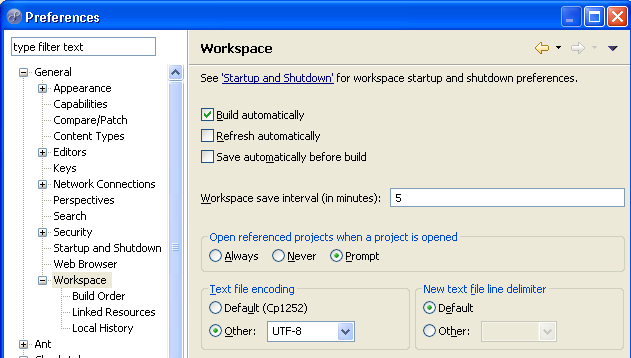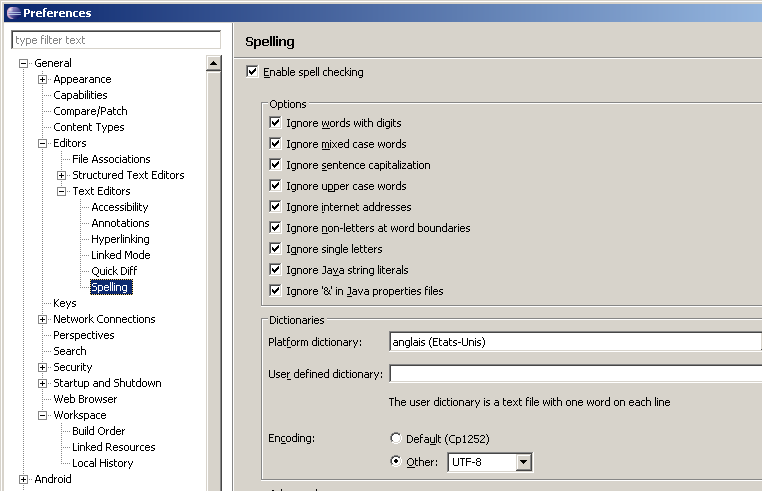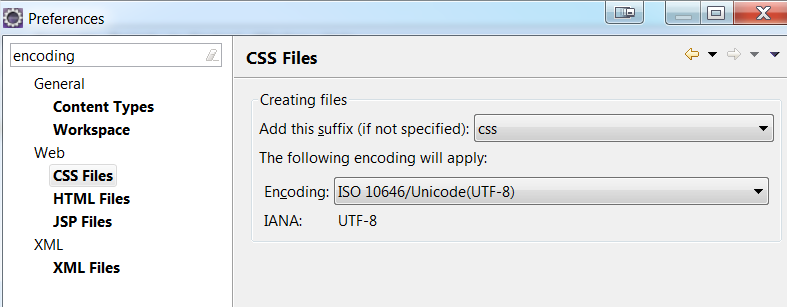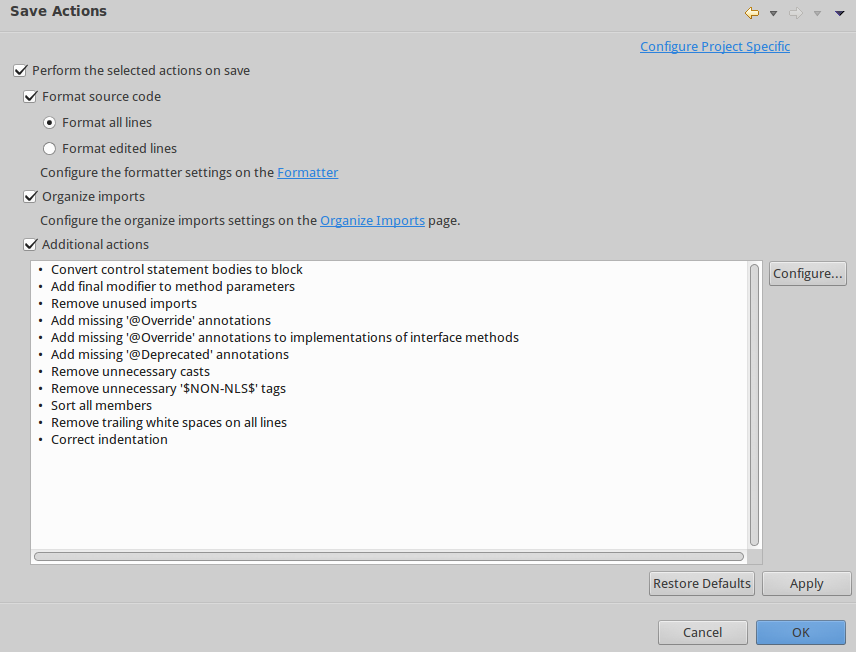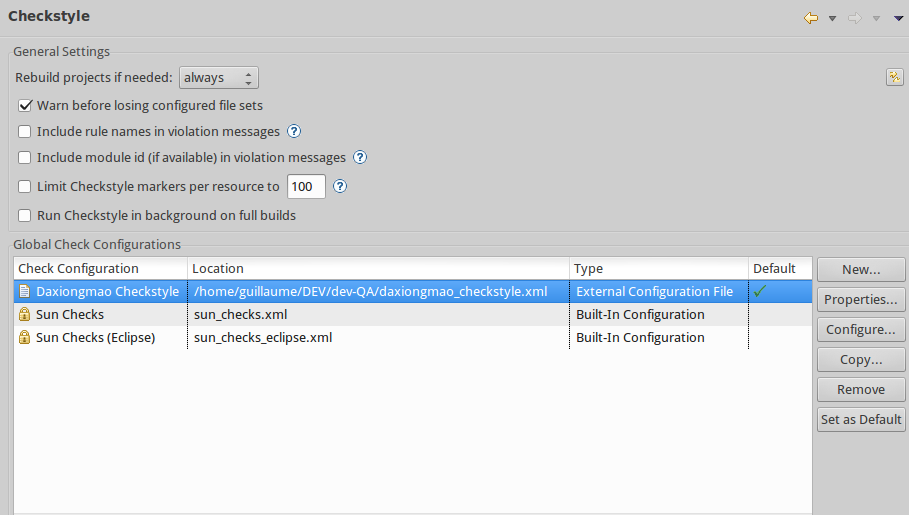Difference between revisions of "Eclipse"
| Line 2: | Line 2: | ||
Eclipse requires a Java JDK to work. | Eclipse requires a Java JDK to work. | ||
See [[JDK setup|Java JDK setup]] | See [[JDK setup|Java JDK setup]] | ||
| + | |||
| Line 15: | Line 16: | ||
==Linux== | ==Linux== | ||
| + | |||
===Basic installation=== | ===Basic installation=== | ||
* Download the eclipse.deb package | * Download the eclipse.deb package | ||
| Line 72: | Line 74: | ||
=Eclipse configuration= | =Eclipse configuration= | ||
| + | |||
==JDK== | ==JDK== | ||
| Line 102: | Line 105: | ||
At the bottom of the script, choose "UTF-8" | At the bottom of the script, choose "UTF-8" | ||
| − | |||
[[File:Eclipse utf8 encoding 1.png|none|Eclipse UTF-8 encoding(1)]] | [[File:Eclipse utf8 encoding 1.png|none|Eclipse UTF-8 encoding(1)]] | ||
| Line 113: | Line 115: | ||
Encode CSS + HTML + JSP + XML in UTF-8 | Encode CSS + HTML + JSP + XML in UTF-8 | ||
| − | |||
[[File:Eclipse utf8 encoding 3.png|none|Eclipse UTF-8 encoding(3)]] | [[File:Eclipse utf8 encoding 3.png|none|Eclipse UTF-8 encoding(3)]] | ||
| Line 135: | Line 136: | ||
==Code formatting== | ==Code formatting== | ||
| + | |||
===Import formatter=== | ===Import formatter=== | ||
Window menu -> Preferences -> Java -> Code style -> Formatter | Window menu -> Preferences -> Java -> Code style -> Formatter | ||
| Line 141: | Line 143: | ||
[[File:eclipse_formatter.png|none|Eclipse formatter]] | [[File:eclipse_formatter.png|none|Eclipse formatter]] | ||
| − | ===Save actions== | + | ===Save actions=== |
Before saving a java file, you can perform some "save actions", that will result in automatic formatting. | Before saving a java file, you can perform some "save actions", that will result in automatic formatting. | ||
Window menu -> Preferences -> Java -> Editor -> Save Actions | Window menu -> Preferences -> Java -> Editor -> Save Actions | ||
| − | Enable Perform the selected actions on save | + | Enable Perform the selected actions on save: |
| − | |||
[[File:eclipse_save_actions.png|none|Eclipse save actions]] | [[File:eclipse_save_actions.png|none|Eclipse save actions]] | ||
| Line 169: | Line 170: | ||
**Remove unused imports | **Remove unused imports | ||
**Remove unnecessary casts + '$NON-NLS' tags | **Remove unnecessary casts + '$NON-NLS' tags | ||
| + | |||
| Line 174: | Line 176: | ||
Eclipse marketplace: http://marketplace.eclipse.org/ | Eclipse marketplace: http://marketplace.eclipse.org/ | ||
| − | |||
| Line 227: | Line 228: | ||
==Checkstyle== | ==Checkstyle== | ||
| + | |||
===Installation=== | ===Installation=== | ||
| Line 236: | Line 238: | ||
* All additional checks | * All additional checks | ||
| + | |||
===Configuration=== | ===Configuration=== | ||
Window menu -> Preferences -> Checkstyle | Window menu -> Preferences -> Checkstyle | ||
| Line 249: | Line 252: | ||
I strongly advised you to commit your formatter.xml; checkstyle.xml; code_templates.xml; cleanup.xml into your SVN project. | I strongly advised you to commit your formatter.xml; checkstyle.xml; code_templates.xml; cleanup.xml into your SVN project. | ||
| + | |||
| + | ===Usage=== | ||
| + | You have to enable / disable checkstyle for each one of your projects. | ||
| + | > Right click on a project -> Properties -> Checkstyle -> Enable checkstyle for this project | ||
| + | |||
| + | You have to open the "Window menu -> Show view -> Others... -> Checkstyle -> Checkstyle violations" to get the analyze results | ||
| + | ==Eclipse Emma Code Coverage== | ||
| + | !! This is a very useful tool that compute the code coverage for jUnit tests (unit & integrations tests) !! :-) | ||
| − | + | '''Installation''' | |
| + | > Update site : http://update.eclemma.org/ | ||
| + | '''Configuration''' | ||
| + | 1. Just Right click on your test folder / test class -> Coverage as... -> jUnit test | ||
| + | 2. You have to open the "Window menu -> Show view -> Java -> "Coverage" to get the analyze results | ||
| + | |||
| + | |||
| + | |||
| + | ==Java Decompiler== | ||
| + | The most famous java decompiler: JADclipse. | ||
| + | > Update site: http://jadclipse.sf.net/update | ||
| + | |||
| + | |||
| + | |||
| + | ==SVN Subclipse== | ||
| + | The SVN subclipse exists in many version. You have to select your version accordingly to your SVN server (v1.6, v1.7, v1.8 ...) | ||
| − | 1. | + | |
| − | + | ===Installation=== | |
| − | + | Update site: | |
| − | + | * SVN 1.7 = http://subclipse.tigris.org/update_1.8.x | |
| + | * SVN 1.8 = http://subclipse.tigris.org/update_1.10.x | ||
| + | Install: | ||
| + | *Subclipse | ||
| + | **Subclipse (required) | ||
| + | **Subclipse integration for Mylyn 3.x | ||
| + | **Subversion client adapter | ||
| + | **Subversion JavaHL Native Library adapter | ||
| + | **Subversion revision graph | ||
| + | The CollabNet is also very useful to branch and merges branch > trunk ! :) | ||
| + | ** CollabNet - collaboration Merge client | ||
| + | |||
| − | ==JavaHL for Subclipse== | + | ===Linux # JavaHL for Subclipse=== |
| − | Source: | + | Source: http://subclipse.tigris.org/wiki/JavaHL Subclipse JavaHL wiki |
Linux requires the JavaHL client for Subclipse: | Linux requires the JavaHL client for Subclipse: | ||
Revision as of 12:54, 26 January 2014
Requirements
Eclipse requires a Java JDK to work. See Java JDK setup
Installation
Download eclipse from the official website: http://eclipse.org/downloads/
Take the Eclipse IDE for Java EE developers version.
Windows
Just extract the archive and run ./eclipse/eclipse.exe
Linux
Basic installation
- Download the eclipse.deb package
- Install the package using:
tar -xzvf eclipse.tar.gz- Launch application by running ./eclipse/eclipse
Create a desktop launcher
sudo vim /usr/share/applications/eclipse.desktopPut the following content where /home/guillaume/DEV/eclipse is the path to Eclipse.
[Desktop Entry]
Version=4.3.0
Name=Eclipse
Comment=Eclipse IDE
Exec=/home/guillaume/DEV/eclipse/eclipse -clean
Icon=/home/guillaume/DEV/eclipse/icon.xpm
Terminal=false
Type=Application
Categories=Utility;Application
Ubuntu 13.10 - launcher Fix
If the menu doesn't appear correctly you must create the following launcher:
[Desktop Entry]
Version=4.3.0
Name=Eclipse
Comment=IDE for all seasons
Exec=env UBUNTU_MENUPROXY=0 /home/guillaume/DEV/eclipse/eclipse -clean
Icon=/home/guillaume/DEV/eclipse/icon.xpm
Terminal=false
Type=Application
Categories=Utility;ApplicationDon't forget the Exec=... line! The key is "env UBUNTU MENUPROXY=0"
SWT libraries fixes
On the latest distribution Eclipse sometimes crashed due to libswt-*.so
To resolve that, install the development libraries:
apt-get install libx11-dev libxtst-dev libgl1-mesa-dev libglu1-mesa-dev libgtk-3-dev
Eclipse configuration
JDK
Window menu -> Preferences -> Java -> Installed JRE
> Add the JDK as a standard VM
> JRE home = JDK root
> Click "Finish"
Select the new JDK as the default one
Preferences -> Java -> Installed JRE -> Execution Environment
> For each java version adjust the JVM to use
Display line numbers
Window menu -> Preferences -> General -> Editors -> Text Editors
> Enable show line numbers
> show print margin (you can adjust the size. I'm using "160")
Increase console size
Window menu -> Preferences -> Run / debug -> Console
If you limit the console output put a hudge value (>= 100 000)
Adjust encoding to UTF-8
By default Eclipse use the same encoding as your O.S, which is probably ISO-8859-1 .You should instead use UTF-8.
Window menu -> Preferences -> General -> Workspace
At the bottom of the script, choose "UTF-8"
Window menu -> Preferences -> General -> Editors -> Text Editors -> Spelling
Choose UTF-8 to encode javadoc
Window menu -> Preferences -> General -> filter "encoding"
Encode CSS + HTML + JSP + XML in UTF-8
On the General -> Content Types, check that everything has default encoding: UTF-8. If the default encoding is blank, then add "UTF-8"
Check:
- Android Binary XML (if available)
- Diagram (if available)
- JAR Content
- Java class File
- Text
- HTML
- Java properties file
- JSP
- CSS JSP
- JSP fragment
- JSP Tag definition
- XML
Code formatting
Import formatter
Window menu -> Preferences -> Java -> Code style -> Formatter
> Import formatter
Save actions
Before saving a java file, you can perform some "save actions", that will result in automatic formatting.
Window menu -> Preferences -> Java -> Editor -> Save Actions Enable Perform the selected actions on save:
Check:
- Perform save actions
- Format source code
- format ALL lines
- Organize imports
- Additional actions
- Format source code
... Configure additional actions:
- Code organizing
- Remove trailing whitespace (all lines)
- Correct indentation
- Sort members
- Code style
- Use block in if/while/for/do statements (always)
- Use modifer "final" where possible (parameter)
- Missing code
- Select all
- Unnecessary code
- Remove unused imports
- Remove unnecessary casts + '$NON-NLS' tags
Eclipse plug-ins
Eclipse marketplace: http://marketplace.eclipse.org/
Maven
Plugins installation and configuration
Maven plugin settings
Window menu -> Preferences -> Maven
Enable:
- download artifact sources
- download artifact javadoc
Window menu -> Preferences -> Maven -> Installation
> Add the path to your own MAVEN 3 installation
Window menu -> Preferences -> Maven -> User Interface
>Open XML page in the POM editor by default [VERY important for performances]
Window menu -> Preferences -> Maven -> User Settings
- Choose the correct settings.xml (the one from your Maven installation instead of ~/.m2/)
- Set the repository path
Run configurations
You can run MAVEN from Eclipse thanks to the run configurations.
Run menu -> Run Configurations -> Maven Build -> [Double click on it]
Create a new run configuration for each maven sequence.
- Configuration (1)
- Name: Maven clean install
- Base directory: ${project_loc}
- Goals: clean install
- Configuration (2) #
- Name: Maven clean install -DskipTests
- Base directory: ${project_loc}
- Goals: clean install
- Options: select "Skip Tests"
Add run configurations to favorite
Click on the arrow of the RUN button (left side) -> Organize favorites
Click "ADD" > Select your configurations Now, you can run your configurations by using the same button.
Checkstyle
Installation
Checkstyle Plug-in
> Update site: http://eclipse-cs.sourceforge.net/update/
Install:
- Eclipse checkstyle plug-in
- All additional checks
Configuration
Window menu -> Preferences -> Checkstyle
You can either:
- Import your own checkstyle set of rule (new -> external configuration file -> browse to your own checkstyle -> set it as default)
- Set the "Sun Check (Eclipse)" as default.
- Duplicate the "Sun Check (Eclipse)" + make your own arrangements and use it as default
-- hint: --
I strongly advised you to commit your formatter.xml; checkstyle.xml; code_templates.xml; cleanup.xml into your SVN project.
Usage
You have to enable / disable checkstyle for each one of your projects.
> Right click on a project -> Properties -> Checkstyle -> Enable checkstyle for this project
You have to open the "Window menu -> Show view -> Others... -> Checkstyle -> Checkstyle violations" to get the analyze results
Eclipse Emma Code Coverage
!! This is a very useful tool that compute the code coverage for jUnit tests (unit & integrations tests) !! :-)
Installation
> Update site : http://update.eclemma.org/
Configuration 1. Just Right click on your test folder / test class -> Coverage as... -> jUnit test 2. You have to open the "Window menu -> Show view -> Java -> "Coverage" to get the analyze results
Java Decompiler
The most famous java decompiler: JADclipse.
> Update site: http://jadclipse.sf.net/update
SVN Subclipse
The SVN subclipse exists in many version. You have to select your version accordingly to your SVN server (v1.6, v1.7, v1.8 ...)
Installation
Update site:
- SVN 1.7 = http://subclipse.tigris.org/update_1.8.x
- SVN 1.8 = http://subclipse.tigris.org/update_1.10.x
Install:
- Subclipse
- Subclipse (required)
- Subclipse integration for Mylyn 3.x
- Subversion client adapter
- Subversion JavaHL Native Library adapter
- Subversion revision graph
The CollabNet is also very useful to branch and merges branch > trunk ! :)
- CollabNet - collaboration Merge client
Linux # JavaHL for Subclipse
Source: http://subclipse.tigris.org/wiki/JavaHL Subclipse JavaHL wiki
Linux requires the JavaHL client for Subclipse:
sudo apt-get install libsvn-javaFind the library file:
sudo find / -name libsvnjavahl-1.soYou should have something like:
guillaume@VC076:~/DEV/eclipse$ sudo find / -name libsvnjavahl-1.so
/usr/lib/x86_64-linux-gnu/jni/libsvnjavahl-1.soNow, update your eclipse.ini configuration
vim eclipse.iniAdd the path without '/' at the end.
-vmargs
-Djava.library.path=/usr/lib/x86_64-linux-gnu/jni→ Note: Ubuntu 13.10 as only the JavaHL 1.7 library. So you should not install SVN client 1.8.x but SVN client 1.7.x !!
